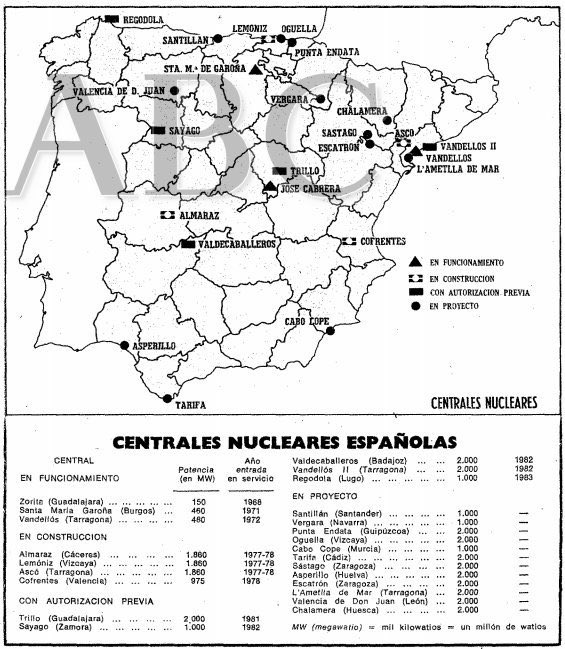⚛️🇪🇸 NUCLEAR POWER IN SPAIN 🇪🇸⚛️
Since we have gained quite a few new followers recently, and they may not speak Spanish, or just not be familiar with the situation and history of nuclear power in Spain, the following thread 🧵 explains where we are, and how we got here.
Since we have gained quite a few new followers recently, and they may not speak Spanish, or just not be familiar with the situation and history of nuclear power in Spain, the following thread 🧵 explains where we are, and how we got here.
First, the basics: Spain currently operates 7 nuclear reactors in 5 power stations, which realiably produce over 7.1 GW. This is enough electricity for over 15 MILLION Spanish households, and over 20% of our grid (and with no greenhouse emissions!). 

But how did we get here?
You may be surprised to know that Spain operated one of the very first nuclear power plants in Europe. It was the José Cabrera Nuclear Power Station (PWR), with its iconic orange dome, commissioned in 1969 after just 4 years of construction.
You may be surprised to know that Spain operated one of the very first nuclear power plants in Europe. It was the José Cabrera Nuclear Power Station (PWR), with its iconic orange dome, commissioned in 1969 after just 4 years of construction.

It was soon followed, in 1971 and '72, by the Santa María de Garoña (BWR) and Vandellós (UNGG) Nuclear Power Plants, both built in 5 years. This first generation of power plants (now shut down) put Spain's small economy at the forefront of the world's nuclear power deployment. 







A remarkably robust national nuclear industry continued to develop, and by 1984 Almaraz 1 & 2 (PWR), Ascó 1 & 2 (PWR) and Cofrentes (BWR) had come online. They, unlike their predecessors, were made in their majority by Spanish companies. And we were just getting started... 





You see, after the 1973 Oil Crisis, and in the style of France's Messmer Plan, Spain had an ambitious nuclear buildout plan. Up to 24 reactors, over 36 GW, were considered at one point. By 1978, 12 (!) reactors were at some point along either construction or planning stages. 



But then, what happened? Where are these 12 reactors? Well, politics.
By the late 70s, a wave of anti-nuclear "environmentalism", fueled by accidents like Three Mile Island and the conflation of military and civilian nuclear technology, was on the upswing.
By the late 70s, a wave of anti-nuclear "environmentalism", fueled by accidents like Three Mile Island and the conflation of military and civilian nuclear technology, was on the upswing.
In this environment, among other political parties, Spain's Socialists (PSOE) chose to run in the '82 general election (only the second one since the return to Democracy) with a moratorium on new nuclear builds in their program, and won by a landslide. 



The goverment then passed the nuclear moratorium in 1984, which suspended all the projects for a larger nuclear buildout. Of the reactors already in construction, the Valdecaballeros nuclear station (2 units) had its construction,over 60% done, stopped due to local opposition... 



... And, most infamously, the Lemóniz Nuclear Power Plant was cancelled, despite being virtually finished, after several bombings by the Basque terrorist group ETA, which culminated with the kidnapping and murder of the project's head engineer. 
https://twitter.com/OperadorNuclear/status/1301250426612965377?s=20

On the other hand, the Vandellós 2 and Trillo (both PWR), plus the aforementioned power plants, finished their construction. Thus, 1988 marked the last time a nuclear power plant came online in Spain, and the high water mark of nuclear's share (38% of our electricity in 1989!). 







In subsequent energy plans in the 1990s, the government was forced to compensate the industry for the loss of investments due to the moratorium, which was eventually lifted in 1997. This compensation took the form of an added surcharge on power bills, which lasted until 2015...
... Which brings us to today. The current (also Socialist) government's "Integrated National Plan for Energy and the Climate" foresees the closure of Spain's nuclear power plants between 2027 and 2035, as part of a supposed transition to a predominantly renewable grid. 

However, the main political parties in Spain are not in agreement over this closure, which likely makes the upcoming general election a crucial decision moment for the future of Spain's nuclear.
In our opinion, closing the Spanish nuclear power plants would be short sighted and eventually counterproductive for both our power grid and the environment. Time and time again, retired nuclear generation gets replaced by baseload fossil, not variable renewables.
Instead, it is imperative to continue to support nuclear power as the safest, cleanest and scalable power technology. And, in time, we should embark in the full nuclear build-out which we were in track for, and rejoin the lead as a world reference in nuclear technology. \FIN
• • •
Missing some Tweet in this thread? You can try to
force a refresh




